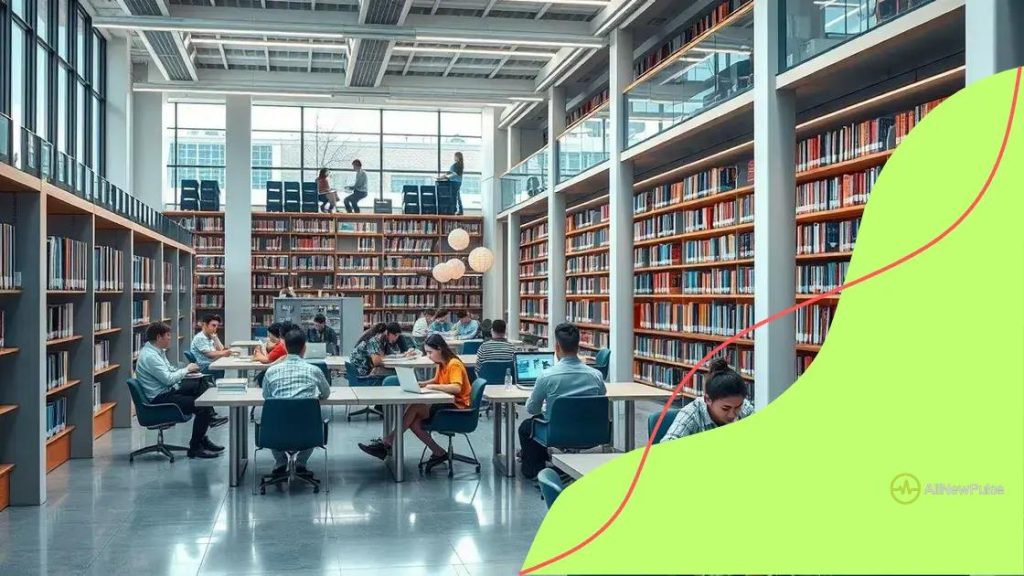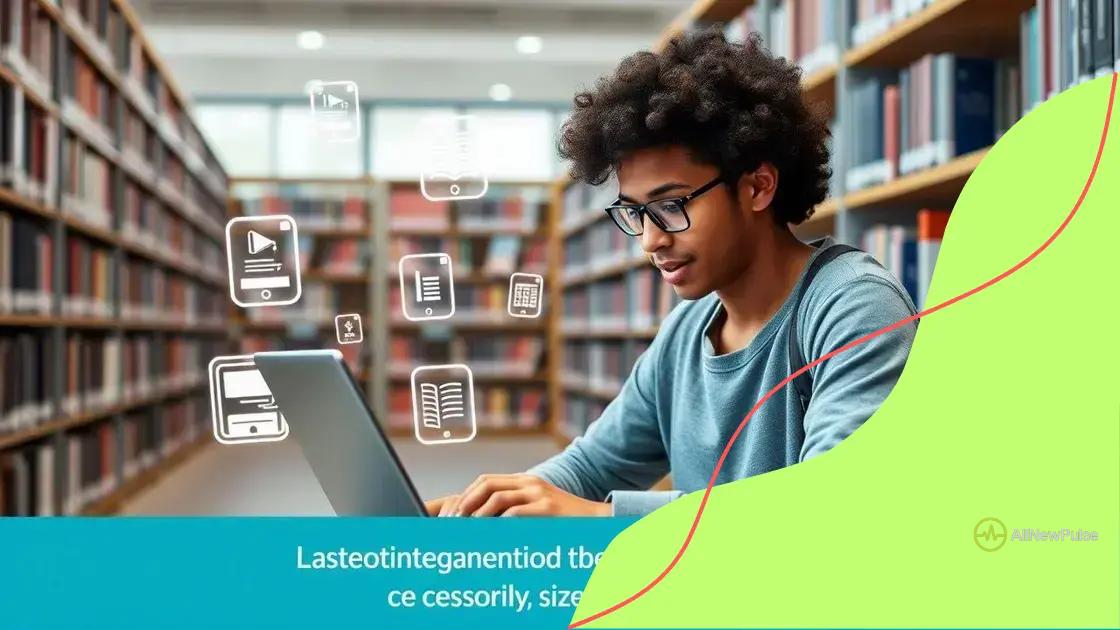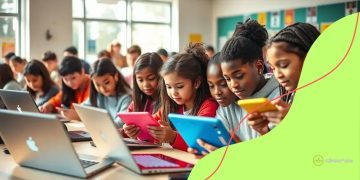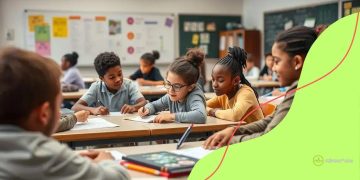The role of libraries in modern education

The role of libraries in modern education is crucial as they provide essential resources, foster digital literacy, and create inclusive learning environments, significantly contributing to student success and community engagement.
The role of libraries in modern education is often underrated, yet these institutions serve as vital hubs for learning. Have you ever considered how libraries can transform educational experiences for students and educators alike?
The evolution of libraries in education
The evolution of libraries in education has been remarkable over the years. Libraries have transformed from mere collections of books to vibrant learning environments that embrace technology and foster community learning. Understanding this evolution is crucial to appreciating the modern library’s role in academia.
In the past, libraries served primarily as quiet spaces for reading and research. However, the digital age has dramatically changed how libraries function. With the advent of the internet, libraries now offer online resources, databases, and digital platforms that make information more accessible.
Modern Libraries
Today’s libraries are not just about books; they are equipped with technology and collaborative spaces. They encourage active learning through various programs and services. Students can access computers, educational programs, and even workshops designed to enhance various skills.
- Hands-on learning experiences
- Technology integration
- Community outreach programs
- Support for diverse learning styles
Libraries have also become community hubs where people gather for various events, workshops, and classes. This shift emphasizes the importance of social learning, where collaboration and interaction enhance educational experiences. Through book clubs, author talks, and educational seminars, libraries engage the community in meaningful ways.
The advancement of technology has also led to the rise of digital libraries, which allow users to access a vast array of resources from anywhere. This has made learning more personalized and accessible, catering to the needs of a diverse audience that includes students, teachers, and lifelong learners.
The Role of Librarians
Librarians play a pivotal role in this evolution. They are not just caretakers of books; they are educators and facilitators who assist in navigating the vast information landscape. With their expertise, they guide students in critical thinking and research skills, ensuring that they can filter through the abundance of information available.
- Providing research assistance
- Teaching information literacy
- Curating relevant resources
- Encouraging lifelong learning
In conclusion, the evolution of libraries in education reflects a broader understanding of learning as a dynamic and interactive process. As technology continues to evolve, so too will libraries, adapting to meet the needs of their communities and paving the way for future generations of learners. Their contribution to education, therefore, is invaluable and continues to grow.
Creating inclusive learning environments
Creating inclusive learning environments is essential for enhancing the educational experience for all students. Inclusive spaces allow every individual to engage meaningfully in the learning process. Fostering inclusivity encourages diversity and helps all learners succeed.
Effective inclusivity starts with accessibility. Libraries can incorporate various resources so everyone can obtain information. This includes physical accessibility for people with disabilities and providing digital resources for students who may face challenges accessing traditional materials.
Strategies for Inclusive Learning
One strategy includes offering programs tailored to different learning styles. By recognizing that not every student learns the same way, libraries can cater to visual, auditory, and kinesthetic learners. Providing multiple formats for information—like videos, audio books, and hands-on activities—promotes engagement.
- Visual aids and infographics
- Interactive learning stations
- Group projects to encourage collaboration
- Librarian-led workshops on various topics
Another vital aspect is the creation of a welcoming atmosphere. The library environment should reflect diversity and foster a sense of belonging. Displays celebrating different cultures and perspectives contribute to students feeling valued and included. Events that celebrate different backgrounds and experiences can help create a supportive community.
Community Involvement
Community involvement is key to developing inclusive learning. Collaborating with local organizations can expand what libraries offer. By partnering with schools and community groups, libraries can attract diverse participants and share resources effectively. Workshops that address specific needs in the community create opportunities for learning while also connecting students with valuable resources.
- Partnerships with local schools
- Involvement in community events
- Inviting guest speakers from diverse backgrounds
- Offering bilingual materials and services
Building an inclusive library environment not only enhances education but also prepares students for the global community. By embracing diverse perspectives and experiences, libraries help to cultivate empathy and understanding among students, which is crucial for their personal development.
Digital resources and library access

Digital resources and library access have transformed how students and educators engage with information. Libraries now provide a wealth of online materials, making learning more accessible than ever. Understanding digital resources is essential for both students and educators seeking to enhance educational experiences.
With the rise of technology, libraries have expanded their collections to include eBooks, online databases, and streaming services. This shift allows users to access a wide range of materials from anywhere at any time. The convenience of digital access means that students can easily engage with the content that suits their learning needs.
Types of Digital Resources
Many libraries offer an array of digital resources designed to support diverse learning objectives. These can include multimedia content, research databases, and virtual learning tools. Accessing these resources often requires a library membership, which many institutions provide for free.
- Electronic books and audiobooks
- Online research databases
- Streaming videos and documentaries
- Interactive educational tools and software
Moreover, virtual reference services have become essential. Librarians are now available online to assist users with research questions and resource navigation. This support helps connect students to the right materials and fosters critical thinking skills. By providing guidance on how to use these digital tools effectively, librarians play an important role in the learning process.
Improving Access to Information
Improving access to digital resources also involves addressing barriers that some users face. Libraries can implement initiatives to ensure that underrepresented groups have equal access to technology. This includes providing access to computers, Wi-Fi, and training on how to use these digital tools.
- Workshops on digital literacy
- Providing technology for students without home access
- Creating resources in multiple languages
- Utilizing social media to promote resources
As we move further into an increasingly digital world, the importance of digital resources and library access will only grow. By embracing technology, libraries can continue to support the educational needs of all students, fostering a love for learning and ensuring that every individual has the tools they need to succeed.
The impact of libraries on student success
The impact of libraries on student success is profound and cannot be overstated. Libraries are more than just a place to borrow books; they are essential for fostering academic achievement and personal growth. Access to library resources plays a critical role in students’ educational journeys.
Research shows that students who regularly utilize library resources perform better academically. Libraries provide access to important materials that enhance research and study skills. With books, articles, and online databases, students can gather information that supports their coursework and personal interests.
Supporting Academic Achievement
Libraries offer various programs that directly support students’ learning. These can include tutoring services, workshops, and study groups. By participating in these programs, students can develop crucial skills and reinforce their understanding of subjects.
- Research assistance from librarians
- Workshops on study strategies and research methods
- Access to collaborative study spaces
- Programs that promote literacy and critical thinking
In addition to supporting academic work, libraries also encourage a love for reading. Engaging students with diverse materials fosters a passion for learning. When students find books or resources that interest them, they are more likely to read and engage with content, which can enhance their overall learning experience.
Promoting Lifelong Learning
Libraries create an environment that promotes lifelong learning, where students can explore topics beyond their curriculum. This includes access to various genres, technology resources, and community programs. By encouraging curiosity and exploration, libraries empower students to become independent learners.
- Access to digital learning tools and platforms
- Programs for skill development like coding or digital storytelling
- Opportunities for community involvement and service
- Events like book fairs and author visits that enrich learning
Moreover, the personal support students receive at libraries fosters a sense of belonging. A welcoming atmosphere can motivate students to seek help and engage more with their studies. When students feel valued and supported, their confidence thrives, further contributing to their success.
Future trends in library services
Future trends in library services are shaping the way libraries will function and serve their communities. As technology continues to advance, libraries are adapting to meet the changing needs of users. Understanding these trends helps to highlight the evolving role of libraries in modern education.
One significant trend is the growing emphasis on digital literacy. Libraries are moving towards integrating technology into their services. This means offering programs that teach users how to navigate the digital world safely and effectively. Workshops focused on essential skills, like coding and online research, help empower users in a tech-driven society.
Embracing Technology
In addition to digital literacy, libraries are enhancing their online services. Many are adopting cloud-based systems to manage resources efficiently. This shift allows users to access materials from anywhere at any time, improving convenience and accessibility. Online resources such as eBooks, audiobooks, and virtual databases are increasingly becoming standard offerings.
- Virtual reality experiences for education
- Online databases and research tools
- Mobile apps for easy access
- Enhanced security for digital resources
Moreover, the trend of community engagement is gaining momentum. Libraries are not just places for books; they are becoming community centers for learning and collaboration. By hosting events, programs, and workshops, libraries encourage community participation. This includes partnerships with local organizations to foster educational opportunities for all ages.
Data-Driven Services
Data-driven decision-making is another important trend. Libraries are using analytics to understand user needs better. Gathering data on how users interact with services allows librarians to tailor offerings accordingly. This means providing resources and programs that align with community interests and demands.
- Customized programming based on user feedback
- Tracking usage statistics to improve services
- Conducting surveys to assess community needs
- Engaging with users through social media for direct input
As libraries embrace these trends, they will continue to play a vital role in promoting education and access to information. By evolving alongside technological advancements and community needs, libraries can ensure that they remain relevant and essential resources for learning.
FAQ – Frequently Asked Questions About Libraries and Education
How do libraries support student success?
Libraries provide access to essential resources, tutoring services, and workshops that enhance academic achievement for students.
What trends are shaping the future of library services?
Future trends include an emphasis on digital literacy, technology integration, community engagement, and data-driven decision-making.
How can technology improve library access?
Technology enables libraries to offer online resources, virtual services, and mobile apps that enhance convenience and accessibility for users.
What role do librarians play in modern education?
Librarians assist students in navigating resources, teach essential skills, and provide personalized support to enhance learning experiences.





